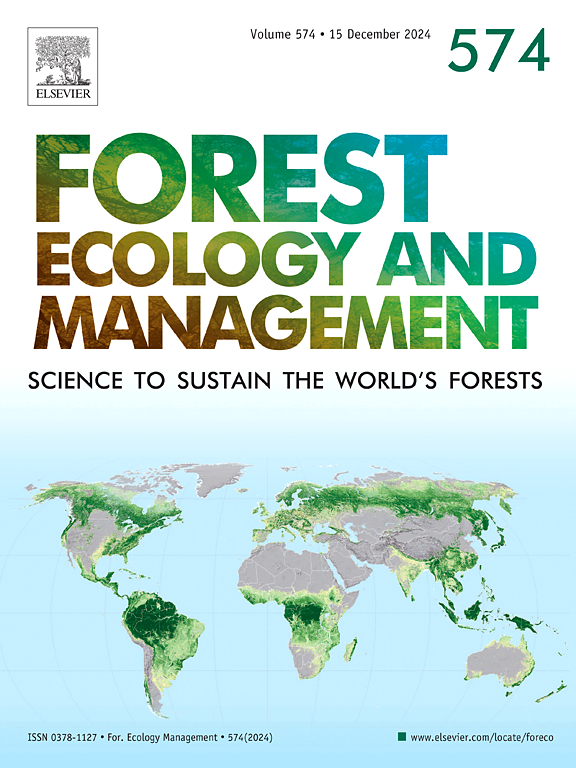森林碳项目需要关注的问题:哥伦比亚倡议分析
IF 3.7
2区 农林科学
Q1 FORESTRY
引用次数: 0
摘要
造林、再造林和植被重建(ARR)项目在应对气候变化方面发挥着至关重要的作用。在哥伦比亚,ARR 项目对于实现森林恢复和温室气体减排目标非常重要。我们的研究全面回顾了哥伦比亚的 74 个 ARR 项目,考察了这些项目的空间分布、特点和恢复性干预措施。这些项目是通过查阅碳登记网页确定的。项目时间表、预计碳清除量、地点、规模、自然区域、生物群落、物种方法、种植物种数量以及恢复性干预措施类型等数据均从项目说明文件、验证、监测和核查报告中提取。总体而言,这些项目处理了 314 374 公顷的面积,在入计期内估计清除了 101 553 801 吨二氧化碳。分析表明,安第斯、加勒比和奥里诺科地区的 ARR 项目数量最多,而太平洋和亚马逊地区的项目数量较少。混合物种种植是最常见的方法,其次是外来物种和本地物种。植树造林是最常见的林业干预措施,其次是农林业。不过,研究也发现了一些令人担忧的趋势,如入侵物种的广泛使用以及在自然非森林生态系统中开展大量植树造林项目。这些发现为哥伦比亚 ARR 项目的管理提供了重要启示,强调了在提高生态和社会效益的同时确保碳固存工作质量的必要性。最后,该研究为哥伦比亚实现生物多样性恢复和气候适应性的更广泛目标提供了支持。本文章由计算机程序翻译,如有差异,请以英文原文为准。
Attention needed in forest carbon projects: An analysis of initiatives in Colombia
Afforestation, reforestation, and revegetation (ARR) projects play a crucial role to combat climate change. In Colombia, ARR projects are important to achieve forest restoration and greenhouse gas emission reduction targets. Our study presents a comprehensive review of 74 ARR projects in Colombia, examining their spatial distribution, characteristics, and restorative interventions. The projects were identified through a review of carbon registry web pages. Data on project timelines, estimated carbon removal, locations, sizes, natural regions, biomes, species approaches, number of planted species, and types of restorative interventions were extracted from project description documents, validation, monitoring and verification reports. Overall, these projects have treated an area of 314,374 ha, with an estimated removal of 101,553,801 tons of CO2 during the crediting period. The analysis revealed that the Andean, Caribbean, and Orinoco regions had the highest number of ARR projects, while the Pacific and Amazon regions had fewer initiatives. Mixed species plantings were the most common approach, followed by exotic and native species. Afforestation was the most frequent forestry intervention, followed by agroforestry. However, the study also identifies concerning trends, such as the widespread use of invasive species and large number of afforestation projects in naturally non-forest ecosystems. These findings offer critical insights for the governance of ARR projects in Colombia, emphasizing the need to assure quality in carbon sequestration efforts while enhancing ecological and social benefits. Finally, the study supports Colombia’s broader goals of biodiversity restoration and climate resilience.
求助全文
通过发布文献求助,成功后即可免费获取论文全文。
去求助
来源期刊

Forest Ecology and Management
农林科学-林学
CiteScore
7.50
自引率
10.80%
发文量
665
审稿时长
39 days
期刊介绍:
Forest Ecology and Management publishes scientific articles linking forest ecology with forest management, focusing on the application of biological, ecological and social knowledge to the management and conservation of plantations and natural forests. The scope of the journal includes all forest ecosystems of the world.
A peer-review process ensures the quality and international interest of the manuscripts accepted for publication. The journal encourages communication between scientists in disparate fields who share a common interest in ecology and forest management, bridging the gap between research workers and forest managers.
We encourage submission of papers that will have the strongest interest and value to the Journal''s international readership. Some key features of papers with strong interest include:
1. Clear connections between the ecology and management of forests;
2. Novel ideas or approaches to important challenges in forest ecology and management;
3. Studies that address a population of interest beyond the scale of single research sites, Three key points in the design of forest experiments, Forest Ecology and Management 255 (2008) 2022-2023);
4. Review Articles on timely, important topics. Authors are welcome to contact one of the editors to discuss the suitability of a potential review manuscript.
The Journal encourages proposals for special issues examining important areas of forest ecology and management. Potential guest editors should contact any of the Editors to begin discussions about topics, potential papers, and other details.
 求助内容:
求助内容: 应助结果提醒方式:
应助结果提醒方式:


